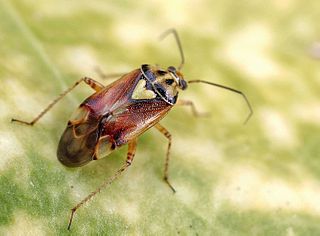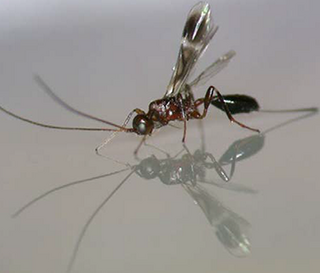Related Research Articles

The superfamily Ichneumonoidea contains one extinct and three extant families, including the two largest families within Hymenoptera: Ichneumonidae and Braconidae. The group is thought to contain as many as 100,000 species, many of which have not yet been described. Like other parasitoid wasps, they were long placed in the "Parasitica", variously considered as an infraorder or an unranked clade, now known to be paraphyletic.

The Miridae are a large and diverse insect family at one time known by the taxonomic synonym Capsidae. Species in the family may be referred to as capsid bugs or "mirid bugs". Common names include plant bugs, leaf bugs, and grass bugs. It is the largest family of true bugs belonging to the suborder Heteroptera; it includes over 10,000 known species, and new ones are being described constantly. Most widely known mirids are species that are notorious agricultural pests that pierce plant tissues, feed on the sap, and sometimes transmit viral plant diseases. Some species however, are predatory.

The genus Lygus includes over 40 species of plant-feeding insects in the family Miridae. The term lygus bug is used for any member of genus Lygus.

Manduca quinquemaculata, the five-spotted hawkmoth, is a brown and gray hawk moth of the family Sphingidae. The caterpillar, often referred to as the tomato hornworm, can be a major pest in gardens; they get their name from a dark projection on their posterior end and their use of tomatoes as host plants. Tomato hornworms are closely related to the tobacco hornworm Manduca sexta. This confusion arises because caterpillars of both species have similar morphologies and feed on the foliage of various plants from the family Solanaceae, so either species can be found on tobacco or tomato leaves. Because of this, the plant on which the caterpillar is found does not indicate its species.

The Braconidae are a family of parasitoid wasps. After the closely related Ichneumonidae, braconids make up the second-largest family in the order Hymenoptera, with about 17,000 recognized species and many thousands more undescribed. One analysis estimated a total between 30,000 and 50,000, and another provided a narrower estimate between 42,000 and 43,000 species.

The tarnished plant bug (TPB), Lygus lineolaris, is a species of plant-feeding insect in the family Miridae. It has piercing-sucking mouthparts and has become a serious pest on small fruits and vegetables in North America. It is considered a highly polyphagous species and feeds on over half of all commercially grown crop plants, but favors cotton, alfalfa, beans, stone fruits, and conifer seedlings. A study done in southwestern Quebec, Canada has investigated the presence of L. lineolaris in a commercial vineyard. This study also indicated that weeds that grow from cultivation of crops serve as an important food source for L. lineolaris. This insect can be found across North America, from northern Canada to southern Mexico. Adults grow up to 6.5 mm in length, and are brown with accents of yellow, orange or red, with a light-colored "V" on the back (dorsal). The genome has recently been sequenced for the first time.

Parasitoid wasps are a large group of hymenopteran superfamilies, with all but the wood wasps (Orussoidea) being in the wasp-waisted Apocrita. As parasitoids, they lay their eggs on or in the bodies of other arthropods, sooner or later causing the death of these hosts. Different species specialise in hosts from different insect orders, most often Lepidoptera, though some select beetles, flies, or bugs; the spider wasps (Pompilidae) exclusively attack spiders. More rarely, parasitoid wasps may use plant seeds as hosts, such as Torymus druparum.

Glyptapanteles is a genus of endoparasitoid wasps found in all continents, except Antarctica. The larvae of the members of Glyptapanteles sp. are distinguished by their ability to manipulate their hosts into serving as bodyguards.

Adelphocoris lineolatus, is commonly known as the Lucerne bug or the alfalfa plant bug, and belongs to the family Miridae. It is an agricultural pest causing vast amounts of damage to numerous crops, but primarily to alfalfa crops around the globe.

Microgastrinae is a subfamily of braconid wasps, encompassing almost 3,000 described species, with an estimated 30,000–50,000 total species. This makes it one of the richest subfamilies with the most species of parasitoid wasps.

Lygus pratensis is a species of plant bug belonging to the family Miridae.

Spathius agrili is a parasitic non-stinging wasp of family Braconidae which is native to North Asia. It is a parasitoid of the emerald ash borer, an invasive species which has destroyed tens of millions of ash trees in its introduced range in North America. As part of the campaign against the emerald ash borer (EAB), American scientists in conjunction with the Chinese Academy of Forestry began searching in 2003 for its natural enemies in the wild, leading to the discovery of several parasitoid wasp species, including Spathius agrili. S. agrili was discovered in Tianjin, China where it is a prevalent parasitoid of EAB larvae in stands of an introduced ash species, and an endemic ash species. S. agrili has been recorded to attack and kill up to 90 percent of EAB larvae.

Dinocampus coccinellae is a braconid wasp parasite of coccinellid beetles, including the spotted lady beetle, Coleomegilla maculata. D. coccinellae has been described as turning its ladybird host into a temporary "zombie" guarding the wasp cocoon. About 25% of Coleomegilla maculata recover after the cocoon they are guarding matures, although the proportion of other ladybird species which recover is much lower.

Cotesia glomerata, the white butterfly parasite, is a small parasitoid wasp species belonging to family Braconidae. It was first described by Carl Linnaeus in his 1758 publication 10th edition of Systema Naturae.
Adelphocoris rapidus, common names for which are rapid plant bug or superb plant bug, is a species of Hemiptera in the family Miridae, that can be found everywhere in the United States, and in the Peace–Athabasca Delta, Canada. The species are larger than other members of the family, and are either yellowish-black or orange-black coloured.
Cotesia urabae is a small wasp, having a black body with yellow-brown legs, characterized by a solitary larval endoparasitoid stage. It is part of a large complex of 11 primary parasitoids of Uraba lugens Walker, many of which are polyphagous. The female inserts its ovipositor into the a U. lugens larva, depositing its eggs there, and it has been found that one female may carry up to 400 eggs. While C. urabae females are able to attack the same larva several times; only one single parasitoid completes its development in each larva.
Aphidius nigripes is a species of parasitoid wasp in the subfamily Aphidiinae of the family Braconidae. It is the most common parasitoid of the potato aphid Macrosiphum euphorbiae in eastern North America. Many other species of aphids may also serve as hosts.

Helopeltis antonii, also known as the tea mosquito bug, are heteropterans found within the Miridae family. They have a relatively large geographical distribution and are a known pest of many agricultural “cash” crops such as cocoa, cashew, and tea. Subsequently, their impact negatively influences economic growth within the regions in which they inhabit. Thus, their impact on humans has caused them to be of great interest biologically, resulting in significant environmental implications.

Dictyotus caenosus, commonly known as the brown shield bug, is an Australian species of stink bug that has been introduced into New Zealand and New Caledonia.
Cuspicona simplex, commonly known as the green potato bug, is a herbivorous species of stink bug native to Australia and introduced to New Zealand. It feeds on nightshades. It is primarily known as a pest of potatoes, tomatoes, and other crops in the nightshade family.
References
- ↑ Lim, K.P.; Stewart, R.K. (1976). "Laboratory Studies on Peristenus Pallipes and P. Pseudopallipes (Hymenoptera: Braconidae), Parasitoids of the Tarnished Plant Bug, Lygus Lineolaris (Hemiptera: Miridae)". The Canadian Entomologist. 108 (8): 815–821. doi:10.4039/ent108815-8.
- ↑ "UniProtKB".
- ↑ SHAHJAHAN, MOHAMMAD (1974). "Erigeron Flowers as a Food and Attractive Odor Source for Peristenus pseudopallipes, a Braconid Parasitoid of the Tarnished Plant Bug". Environmental Entomology. 3: 69–72. doi:10.1093/ee/3.1.69.
- 1 2 Broadbent, AB; et al. (2006). "Native braconid parasitism of the Tarnished plant bug (Hemiptera: Miridae) in Southern Ontario". Biocontrol Science and Technology. 16 (7): 687–698. doi:10.1080/09583150600699853.
- 1 2 3 Lachance, S; et al. (2001). "In-Host Compatibility and In-Host Competition of Exotic and Native Parasitoids of the Tarnished Plant Bug (Heteroptera: Miridae)". Environmental Entomology. 30 (6): 1158–1163. doi: 10.1603/0046-225X-30.6.1158 .
- ↑ Hudson W et al. (2010). Peristenus relictus (stygicus) (Hymenoptera: Braconidae) A Possible Biological Control Agent For Tarnished Plant Bug, Lygus lineolaris, (Hemiptera: Miridae) In New Jersey Phillip Alampi Beneficial Insect Laboratory Division of Plant Industry